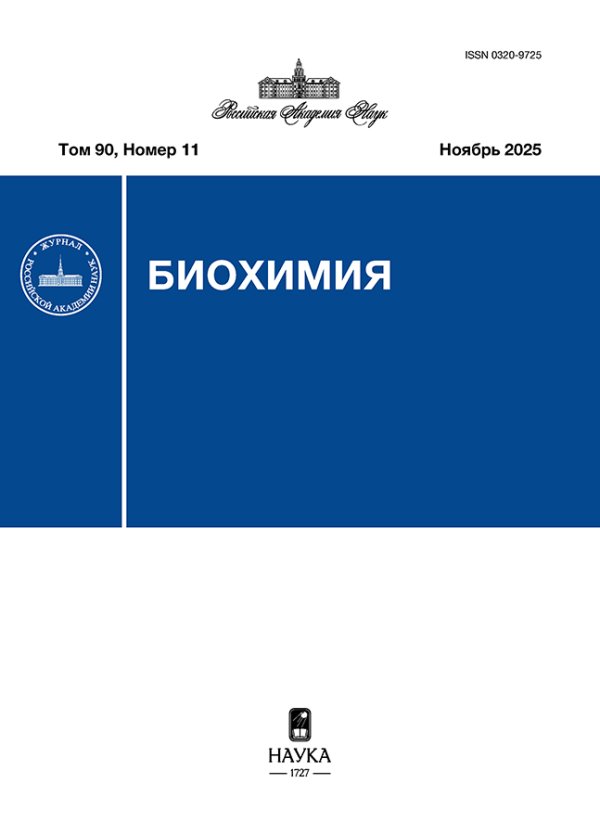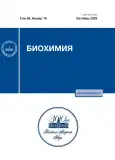Протеомный подход для исследования экспрессии, локализации и функций белкового продукта гена SOWAHD в процессе гранулоцитарной дифференцировки
- Авторы: Новикова С.Е1, Толстова Т.В1, Соловьева Н.А1, Фарафонова Т.Е1, Тихонова О.В1, Курбатов Л.К1, Русанов А.Л1, Згода В.Г1
-
Учреждения:
- НИИ биомедицинской химии имени В.Н. Ореховича
- Выпуск: Том 88, № 10 (2023)
- Страницы: 2014-2031
- Раздел: Регулярные статьи
- URL: https://journals.rcsi.science/0320-9725/article/view/233524
- DOI: https://doi.org/10.31857/S0320972523100196
- EDN: https://elibrary.ru/OYBYYU
- ID: 233524
Цитировать
Полный текст
Аннотация
Об авторах
С. Е Новикова
НИИ биомедицинской химии имени В.Н. Ореховича
Email: novikova.s.e3101@gmail.com
119121 Москва, Россия
Т. В Толстова
НИИ биомедицинской химии имени В.Н. Ореховича119121 Москва, Россия
Н. А Соловьева
НИИ биомедицинской химии имени В.Н. Ореховича119121 Москва, Россия
Т. Е Фарафонова
НИИ биомедицинской химии имени В.Н. Ореховича119121 Москва, Россия
О. В Тихонова
НИИ биомедицинской химии имени В.Н. Ореховича119121 Москва, Россия
Л. К Курбатов
НИИ биомедицинской химии имени В.Н. Ореховича119121 Москва, Россия
А. Л Русанов
НИИ биомедицинской химии имени В.Н. Ореховича119121 Москва, Россия
В. Г Згода
НИИ биомедицинской химии имени В.Н. Ореховича
Email: victor.zgoda@gmail.com
119121 Москва, Россия
Список литературы
- Consortium UniProt (2023) UniProt: The Universal Protein Knowledgebase in 2023, Nucleic Acids Res., 51, D523-D531, doi: 10.1093/nar/gkac1052.
- Lane, L., Argoud-Puy, G., Britan, A., Cusin, I., Duek, P. D., Evalet, O., Gateau, A., Gaudet, P., Gleizes, A., Masselot, A., et al. (2012) NeXtProt: a knowledge platform for human proteins, Nucleic Acids Res., 40, D76-83, doi: 10.1093/nar/gkr1179.
- Uhlén, M., Fagerberg, L., Hallström, B. M., Lindskog, C., Oksvold, P., Mardinoglu, A., Sivertsson, Å., Kampf, C., Sjöstedt, E., Asplund, A., et al. (2015) Proteomics. Tissue-based map of the human proteome, Science, 347, 1260419, doi: 10.1126/science.1260419.
- Kim, M. S., Pinto, S. M., Getnet, D., Nirujogi, R. S., Manda, S. S., Chaerkady, R., Madugundu, A. K., Kelkar, D. S., Isserlin, R., Jain, S., et al. (2014) A draft map of the human proteome, Nature, 509, 575-581, doi: 10.1038/nature13302.
- Adhikari, S., Nice, E. C., Deutsch, E. W., Lane, L., Omenn, G. S., Pennington, S. R., Paik, Y. K., Overall, C. M., Corrales, F. J., Cristea, I. M., et al. (2020) A high-stringency blueprint of the human proteome, Nat. Commun., 11, 5301, doi: 10.1038/s41467-020-19045-9.
- Salzberg, S. L. (2018) Open questions: how many genes do we have? BMC Biol., 16, 94, doi: 10.1186/s12915-018-0564-x.
- Kopylov, A. T., Ponomarenko, E. A., Ilgisonis, E. V., Pyatnitskiy, M. A., Lisitsa, A. V., Poverennaya, E. V., Kiseleva, O. I., Farafonova, T. E., Tikhonova, O. V., Zavialova, M. G., et al. (2019) 200+ protein concentrations in healthy human blood plasma: targeted quantitative SRM SIS screening of chromosomes 18, 13, Y, and the mitochondrial chromosome encoded proteome, J. Proteome Res., 18, 120-129, doi: 10.1021/acs.jproteome.8b00391.
- Poverennaya, E., Kiseleva, O., Ilgisonis, E., Novikova, S., Kopylov, A., Ivanov, Y., Kononikhin, A., Gorshkov, M., Kushlinskii, N., Archakov, A., et al. (2020) Is it possible to find needles in a haystack? Meta-analysis of 1000+ MS/MS files provided by the Russian proteomic consortium for mining missing proteins, Proteomes, 8, 12, doi: 10.3390/PROTEOMES8020012.
- Paik, Y. K., Overall, C. M., Corrales, F., Deutsch, E. W., Lane, L., and Omenn, G. S. (2018) toward completion of the human proteome parts list: progress uncovering proteins that are missing or have unknown function and developing analytical methods, J. Proteome Res., 17, 4023-4030, doi: 10.1021/acs.jproteome.8b00885.
- Thul, P. J., and Lindskog, C. (2018) The human protein atlas: a spatial map of the human proteome, Protein Sci., 27, 233-244, doi: 10.1002/pro.3307.
- Van Bortle, K., and Corces, V. G. (2012) Nuclear organization and genome function, Annu. Rev. Cell Dev. Biol., 28, 163-187, doi: 10.1146/annurev-cellbio-101011-155824.
- Vakhrushev, I. V., Novikova, S. E., Tsvetkova, A. V., Karalkin, P. A., Pyatnitskii, M. A., Zgoda, V. G., and Yarygin, K. N. (2018) Proteomic profiling of HL-60 cells during ATRA-induced differentiation, Bull. Exp. Biol. Med., 165, 530-543, doi: 10.1007/s10517-018-4210-y.
- Novikova, S., Tolstova, T., Kurbatov, L., Farafonova, T., Tikhonova, O., Soloveva, N., Rusanov, A., Archakov, A., and Zgoda, V. (2022) Nuclear proteomics of induced leukemia cell differentiation, Cells, 11, 3221, doi: 10.3390/cells11203221.
- Zheng, P. Z., Wang, K. K., Zhang, Q. Y., Huang, Q. H., Du, Y. Z., Zhang, Q. H., Xiao, D. K., Shen, S. H., Imbeaud, S., Eveno, E., et al. (2005) Systems analysis of transcriptome and proteome in retinoic acid/arsenic trioxide-induced cell differentiation apoptosis of promyelocytic leukemia, Proc. Natl. Acad. Sci. USA, 102, 7653-7658, doi: 10.1073/pnas.0502825102.
- Wang, W.-J., Tang, W., and Qiu, Z.-Y. (2009) Comparative proteomics analysis on differentiation of human promyelocytic leukemia HL-60 cells into granulocyte and monocyte lineages, Chinese J. Cancer, 28, 117-121.
- Novikova, S., Tikhonova, O., Kurbatov, L., Farafonova, T., Vakhrushev, I., Lupatov, A., Yarygin, K., and Zgoda, V. (2021) Omics technologies to decipher regulatory networks in granulocytic cell differentiation, Biomolecules, 11, 907, doi: 10.3390/biom11060907.
- Jian, P., Li, Z. W., Fang, T. Y., Jian, W., Zhuan, Z., Mei, L. X., Yan, W. S., and Jian, N. (2011) Retinoic acid induces HL-60 cell differentiation via the upregulation of MiR-663, J. Hematol. Oncol., 4, 20, doi: 10.1186/1756-8722-4-20.
- Schwanhäusser, B., Gossen, M., Dittmar, G., and Selbach, M. (2009) Global analysis of cellular protein translation by pulsed SILAC, Proteomics, 9, 205-209, doi: 10.1002/pmic.200800275.
- Claydon, A. J., and Beynon, R. (2012) Proteome dynamics: revisiting turnover with a global perspective, Mol. Cell. Proteomics, 11, 1551-1565, doi: 10.1074/mcp.O112.022186.
- Ross, A. B., Langer, J. D., and Jovanovic, M. (2021) Proteome turnover in the spotlight: approaches, applications, and perspectives, Mol. Cell. Proteomics, 20, doi: 10.1074/mcp.R120.002190.
- Holman, S. W., Hammond, D. E., Simpson, D. M., Waters, J., Hurst, J. L., and Beynon, R. J. (2016) Protein turnover measurement using selected reaction monitoring-mass spectrometry (SRM-MS), Philos. Trans. R. Soc. A Math. Phys. Eng. Sci., 374, 20150362, doi: 10.1098/rsta.2015.0362.
- Patro, R., Duggal, G., Love, M. I., Irizarry, R. A., and Kingsford, C. (2017) Salmon provides fast and bias-aware quantification of transcript expression, Nat. Methods, 14, 417-419, doi: 10.1038/nmeth.4197.
- Novikova, S. E., Vakhrushev, I. V., Tsvetkova, A. V., Shushkova, N. A., Farafonova, T. E., Yarygin, K. N., and Zgoda, V. G. (2019) Proteomics of transcription factors: identification of pool of HL-60 cell line-specific regulatory proteins [in Russian], Biomed. Khim., 65, doi: 10.18097/PBMC20196504294.
- Wiśniewski, J. R., Zougman, A., Nagaraj, N., and Mann, M. (2009) Universal sample preparation method for proteome analysis, Nat. Methods, 6, 359-362, doi: 10.1038/nmeth.1322.
- Mohammad, N. S., Nazli, R., Zafar, H., and Fatima, S. (2022) Effects of lipid based multiple micronutrients supplement on the birth outcome of underweight pre-eclamptic women: a randomized clinical trial, Pak. J. Med. Sci., 38, 219-226, doi: 10.12669/pjms.38.1.4396.
- Liu, Y., Mi, Y., Mueller, T., Kreibich, S., Williams, E. G., Van Drogen, A., Borel, C., Frank, M., Germain, P.-L., Bludau, I., et al. (2019) Multi-omic measurements of heterogeneity in HeLa cells across laboratories, Nat. Biotechnol., 37, 314-322, doi: 10.1038/s41587-019-0037-y.
- Zhu, Q., Wang, J., Zhang, Q., Wang, F., Fang, L., Song, B., Xie, C., and Liu, J. (2020) Methylation-driven Genes PMPCAP1, SOWAHC and ZNF454 as potential prognostic biomarkers in lung squamous cell carcinoma, Mol. Med. Rep., 21, 1285-1295, doi: 10.3892/mmr.2020.10933.
- Ruan, B., Feng, X., Chen, X., Dong, Z., Wang, Q., Xu, K., Tian, J., Liu, J., Chen, Z., Shi, W., et al. (2020) Identification of a set of genes improving survival prediction in kidney renal clear cell carcinoma through integrative reanalysis of transcriptomic data, Dis. Markers, 2020, 8824717, doi: 10.1155/2020/8824717.
- Mori, Y., Yokota, H., Hoshino, I., Iwatate, Y., Wakamatsu, K., Uno, T., and Suyari, H. (2021) Deep learning-based gene selection in comprehensive gene analysis in pancreatic cancer, Sci. Rep., 11, 16521, doi: 10.1038/s41598-021-95969-6.
- Gillespie, M., Jassal, B., Stephan, R., Milacic, M., Rothfels, K., Senff-Ribeiro, A., Griss, J., Sevilla, C., Matthews, L., Gong, C., et al. (2022) The reactome pathway knowledgebase, Nucleic Acids Res., 50, D687-D692, doi: 10.1093/nar/gkab1028.
- Kanehisa, M., Sato, Y., Kawashima, M., Furumichi, M., and Tanabe, M. (2016) KEGG as a reference resource for gene and protein annotation, Nucleic Acids Res., 44, D457-62, doi: 10.1093/nar/gkv1070.
- Han, H., Shim, H., Shin, D., Shim, J. E., Ko, Y., Shin, J., Kim, H., Cho, A., Kim, E., Lee, T., et al. (2015) TRRUST: a reference database of human transcriptional regulatory interactions, Sci. Rep., 5, 11432, doi: 10.1038/srep11432.
- Lin, Y., Mehta, S., Küçük-McGinty, H., Turner, J. P., Vidovic, D., Forlin, M., Koleti, A., Nguyen, D.-T., Jensen, L. J., Guha, R., et al. (2017) Drug target ontology to classify and integrate drug discovery data, J. Biomed. Semantics, 8, 50, doi: 10.1186/s13326-017-0161-x.
- Mathieson, T., Franken, H., Kosinski, J., Kurzawa, N., Zinn, N., Sweetman, G., Poeckel, D., Ratnu, V. S., Schramm, M., Becher, I., et al. (2018) Systematic analysis of protein turnover in primary cells, Nat. Commun., 9, 689, doi: 10.1038/s41467-018-03106-1.
- Gomez, G., Lee, J. H., Veldman, M. B., Lu, J., Xiao, X., and Lin, S. (2012) Identification of vascular and hematopoietic genes downstream of etsrp by deep sequencing in zebrafish, PLoS One, 7, e31658, doi: 10.1371/journal.pone.0031658.
- Szklarczyk, D., Kirsch, R., Koutrouli, M., Nastou, K., Mehryary, F., Hachilif, R., Gable, A. L., Fang, T., Doncheva, N. T., Pyysalo, S., et al. (2023) The STRING database in 2023: protein-protein association networks and functional Enrichment analyses for any sequenced genome of interest, Nucleic Acids Res., 51, D638-D646, doi: 10.1093/nar/gkac1000.
- Kang, Y., Xie, H., and Zhao, C. (2019) Ankrd45 is a novel ankyrin repeat protein required for cell proliferation, Genes (Basel), 10, 462, doi: 10.3390/genes10060462.
- Kumar, A., and Balbach, J. (2021) Folding and stability of ankyrin repeats control biological protein function, Biomolecules, 11, 840, doi: 10.3390/biom11060840.
Дополнительные файлы










